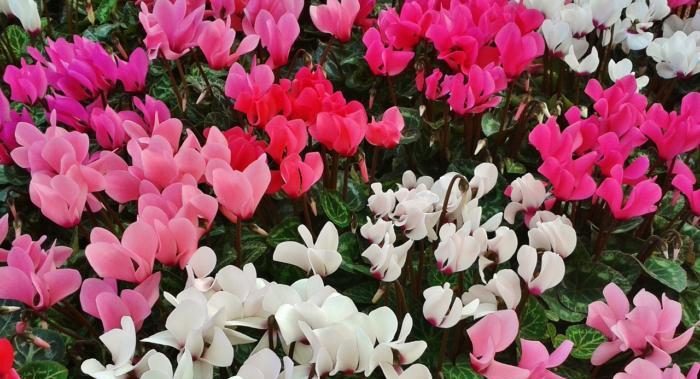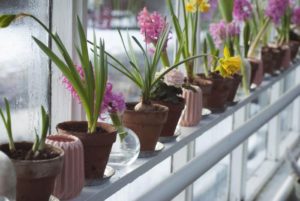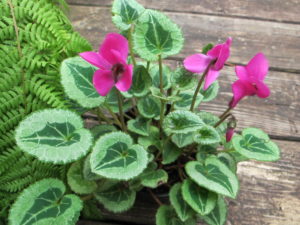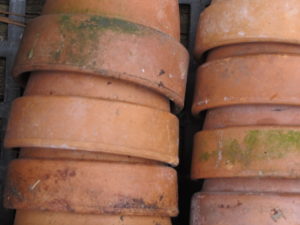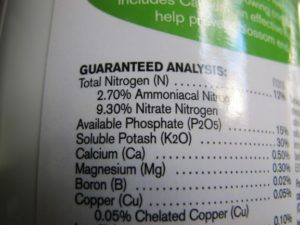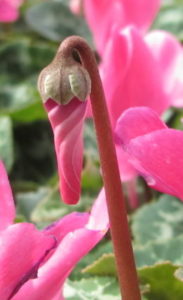Page 2
Starting Out With Cyclamen
Growers receive them as bare tubers or as started plants months ahead of the blooming season. Tubers are half-buried in soil, unlike the hardy species, which are planted underground. Cyclamen must be fertilized for the best-looking foliage and numerous flower buds.
Cool weather stimulates cyclamen to form flower buds. That’s when you’ll see them in garden centers.
Choosing Cyclamen
Look for plants that have healthy foliage—no fuzzy gray mold (Botrytis) or yellow leaves.
Spider mites, aphids, and scale insects sometimes trouble cyclamen. Treat pests with a solution of horticultural oil. Spray all surfaces, top and bottom. This not only suffocates the pests and their eggs, but also cleans up the foliage, removing chalky water and fertilizer residues. Try not to spray the flowers, unless they, too, have insects or mites, and follow up with a clear water rinse. Tap the plant on the table to get water off the tuber. Always read the label.
Avoid plants with leaves that are hard, stunted, or distorted, and flowers that refuse to open. Those plants probably have cyclamen mites, which are notoriously difficult to treat. If your plant develops these symptoms and you enjoy a challenge, try warm-water submersion (110°F for 15 or 20 minutes), horticultural oil, or systemic insecticides. Also, vacuum or clean the area where it was kept. Isolate the infected plant until new growth looks normal, or discard it and start over with a new one.
Remove faded flowers and dead leaves, and remove the entire stem. Any part of the stem remaining after snipping can rot. This mold can infect nearby leaves and flowers.
Water
Cyclamen plants visibly collapse when the soil becomes too dry. A wilted plant usually recovers, but it often sacrifices some leaves, which turn yellow. Remove yellow leaves. Water before plants wilt, and water thoroughly. Wait until the soil surface or the top inch is dry before watering again, but not to the point of wilt.
 Cyclamen also can collapse from soil that is too wet. Wet soil blocks the roots’ access to oxygen and kills off tiny root hairs. The plant is then unable to absorb water. Cyclamen won’t recover after the roots or the tubers have rotted.
Cyclamen also can collapse from soil that is too wet. Wet soil blocks the roots’ access to oxygen and kills off tiny root hairs. The plant is then unable to absorb water. Cyclamen won’t recover after the roots or the tubers have rotted.
These plants need freely draining soil, and should be kept evenly moist. Pour off excess water in the saucer or the pot cover within 10 minutes. Avoid wetting the foliage or the tuber. Leaf and flower stems rise in great numbers from the tuber, and any water sitting in that congested area invites rot. Use a narrow-spouted watering can (photo, right) to direct water to the soil surface, away from the crown of the plant.
Watering from the Saucer
Some of the fertilizer salts in the soil dissolve each time a plant is watered from the saucer. Those soluble salts rise in the soil due to capillarity. This material concentrates at the soil surface as the water evaporates, appearing as a whitish crust.
Excess fertilizer can damage the tuber if you routinely water from below. Instead, water every other time from the top to redistribute fertilizer evenly through the soil profile.
Use cool water because…
…They Like It Cool
Temperatures in the high 40’s up to 65° F are ideal for most types of florist’s cyclamen. If your home is on the warm side, there are usually pockets of cooler temperatures that would keep cyclamen happy.
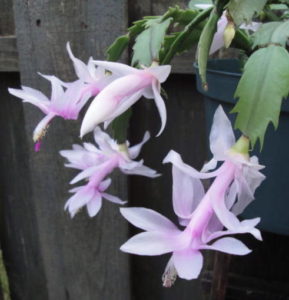
Christmas cactus.
Where I live, with Mother, who needs her low 70’s, the kitchen floor near the not-so-well-insulated patio door is the perfect spot. That’s where Christmas cactus, Drimiopsis, Ledebouria, amaryllis, ferns, and the miniature cyclamen reside. We set the temperature at 65° during the nighttime hours, but it can dip into the 50’s in that location.
The cyclamen had been growing on the deck all summer until frosty weather threatened in mid-autumn. By then, the Christmas cactus and cyclamen had already budded up.
See if you have a chilly window where the plant can stay. If the cyclamen receives good sunlight and favorable temperatures generally, such as at night, it will endure slightly warmer temperatures in the daytime. In addition, newer cultivars are more tolerant of higher temperatures than the varieties of yesteryear. Keep it away from warm dry air.
Lowering the thermostat and clustering plants together will raise the relative humidity for all of them. You also can place plants on pebble trays. Simply fill a large saucer with gravel and water, and maintain the water level below the bottom of the pots. Make sure the pots aren’t touching the water. Evaporating water will increase humidity around those plants.
Miniature Cyclamen Might Be Easier
Although I prefer the miniatures, I have grown standard varieties. But the miniatures seem to be less finicky when it comes to temperature. In fact, the little plant I carried over from Christmas 2017 survived the summer’s heat outdoors, in part shade, and it had a few blooms all summer long. Foliage didn’t look great by late summer, though.
(***Update***: 1/28/19. After cool temperatures and three fertilizer applications, new foliage has emerged, along with about 15 or 20 blooms. The same plant [photo, below] five months later, in mid summer, and still blooming!)
On a Chilly Porch
In this part of the Southeast U.S., we often enjoy moderate winter temperatures outdoors. If you have a cozy spot on the porch that gets some sun, and it’s in the high 40’s or warmer, put your indoor cyclamen outside for a few hours. Don’t leave it outside if frost is in the forecast.
In a protected spot, not exposed to wind, these plants can take it quite cold. If your plant has been sweating it out at 74°F, however, don’t put it outside right away. Gradually expose it to lower temperatures to prevent shock, which will cause wilt.
Some of my customers offered a cheerful welcome to visitors by keeping their cyclamen on the front porch. They kept them in decorative containers, and a roof protected them from harsh conditions. As long as they received adequate light and didn’t freeze, these cyclamen bloomed outdoors for several weeks or even months.
Dormancy
Plants that prefer cool conditions escape summer’s torment by going dormant during hot weather. This is what florist’s cyclamen does, usually, but sometimes it keeps its foliage. If the plant goes semi or fully dormant in summer, keep it on the dry side.
A shady spot outdoors, in some humidity, will give the plant a well-deserved rest. Avoid over-irrigation by tilting the pot on its side. A small amount of water now and then will keep the tuber alive. These conditions mimic cyclamen’s growth pattern in a Mediterranean summer. Alternatively, the plant can remain dormant indoors, but air conditioning could dry the tuber, so occasionally sprinkle a bit of water on the soil. If it keeps some leaves, water it often enough to prevent wilt.
Cyclamen regrows in late summer and autumn. This is a good time to refresh the soil, when you first notice new leaves growing. Some gardeners prefer to repot into fresh soil while the plant is dormant. I didn’t disturb the cyclamen that had kept a few leaves through the summer into fall, though, because they also had a few flowers. Remove most old soil and repot with the tuber half-exposed. Use the same size pot instead of a larger one, unless it was undersized to begin with. What size is best? Read on…
New Digs
Miniatures rarely need pots larger than 4½” in diameter, and the largest standards thrive in 6″ or 7″ containers.
Around the holidays, stores offer micro mini cyclamen in 2″ pots. Tuck these adorable little bloomers into small ceramics for table decorations or add them to mixed baskets for a spot of color. Check for dryness daily.
Plants—especially cyclamen—in larger pots and in less than ideal conditions are at higher risk of rotting from overwatering. Plants with limited root systems prefer smaller pots. For all plants, it’s easier to keep them potbound and to water more often than it is to rehabilitate an overpotted, overwatered plant that’s rotting. Once cyclamen begins to rot, it will die.
Potting Soil
Use well-drained potting soil. Mix in drainage material, such as pine fines, coarse sand, or perlite if your soil is too heavy or stays wet for a period of time. After repotting, water conservatively. As roots fill the container and leaf surface area increases, you’ll need to water more often.
The pH should be slightly acidic to near neutral. Soil with a lot of peat moss should have lime added, if it doesn’t already include it.
Fertilizer for Cyclamen
While the plant is bulking up in preparation for blooms, fertilize every 3 weeks with a balanced fertilizer. For best results, use one that that does not have a high amount of nitrogen.
Don’t overfertilize, as that will damage the roots and possibly kill the plant. If in doubt, or if your growing conditions are less than perfect, use only half the amount recommended on the label. But do continue to fertilize the plant every month or so, as long as it’s flowering or forming new leaves. When the plant stops blooming and looks as though it’s entering dormancy, stop fertilizing.
The first of the 3 numbers on the package represents the percentage of nitrogen, followed by phosphorus (phosphate) and potassium (potash). N-P-K, by the way, always appear in that order, Nitrogen-Phosphorus-Potassium. So, for cyclamen, look for a lower first number (N) compared to the second number (P).
Also on the fertilizer label, you’ll see an analysis listing major nutrients and minor nutrients included in the product. Nitrogen is available in most fertilizers as both ammoniacal and nitrate compounds (photo, above), in varying percentages. Plants that prefer a higher pH, such as cyclamen, grow better with a greater percentage of nitrates relative to ammoniacal nitrogen. A larger proportion of ammoniacal nitrogen could make the cyclamen too “leafy” because it is faster acting and causes more stretched growth. This type of N also tends to lightly acidify the soil.
Light
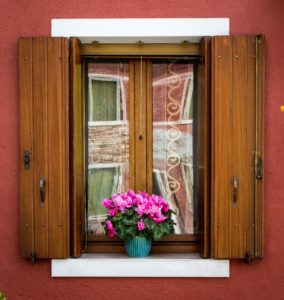
This is where I differ with most sources of information. Cyclamen grown in nurseries receive many hours of direct sunlight, except when the temperatures are still summer-like. When it’s hot in the greenhouse, growers pull shade cloth overhead, lowering the temperature and the sun’s strength until cooler weather returns.
Furthermore, cyclamen that gets sun at the garden center will expect the same amount of light in your home. It will tolerate fewer hours of sun, but it still wants some! And this is where I disagree with many websites that advise against exposing cyclamen to any direct sunlight.
When indirect light is all the plant gets, mature buds will grow and open. But they will be pale in comparison with those that opened in the sun.
New flower buds emerging in indirect light might not have enough energy to grow above the leaf canopy. Consequently, those buds will fail, and the plant will stop producing flower buds altogether.
Foliage that develops in indirect light, with no direct sun, will grow long, weak petioles (leaf stems). In fact, leaves emerging from the tuber might not turn green at all and wither instead. The lower the light level, the faster the decline.
Yes, direct sunlight is warmer…
…but if you keep your home on the cool side, or place the plant in a cool spot overnight, your plant can continue to flower for months and months…assuming proper watering and fertilizing, that is. Adequate light provides a strong foundation on which the plant can continue to function. Without good light, foliage weakens, flower buds stop being produced, and the plant creeps gradually closer to the compost pile.
As long as healthy foliage continues to grow, the plant potentially can form a flower bud for each leaf. That’s how the plant can stay in bloom for a long period of time. So, do what you can to keep those leaves growing!
Almost all plants grown indoors in the winter, including maidenhair ferns, benefit from a few hours of direct sunlight. Morning sun, from an east-facing window, is cooler and more gentle than a west- or a south-facing window (in the northern hemisphere). Place the plants far enough from the glass so they won’t be affected by the heat.
Stems and leaves grow thicker and carry out more photosynthesis, making a sturdier plant. If you have a houseplant that seems weak or isn’t growing, try increasing the amount of light it receives.
As the sun strengthens in spring, some plants might have to be moved to a cooler or shadier location. But continue to give cyclamen a few hours of direct sunlight. Look for some of the newer varieties that can tolerate higher temperatures, such as ‘Leopardo’.
Deadheading Cyclamen
Remove all yellow leaves and faded flowers. When the old flower drops off, remove it and the stem that held it before seeds develop. With one hand, firmly hold the soil surface. With the other hand, grasp the stem, and give it a quick tug.
This should cleanly separate the stem from the tuber, although, rarely, a small piece of the tuber might break loose.
If you delay this procedure, though, the flower or leaf stem will begin to degrade, and you might get only part of the mushy stem. Try to remove the rest of the stem to prevent rot.
Not only is this more aesthetically pleasing, but the plant will have been foiled in its attempt to produce seeds—the next generation. It reacts to this situation by producing more growth and more flowers in an effort to produce seeds.
If you’re up to challenging your horticultural skills, see how long you can keep a cyclamen going. You might want to save that last seedpod you didn’t remove, and try germinating the seeds. Above all, enjoy these delightful little plants!
For Further Research
Cyclamen enthusiasts might contact The North American Rock Garden Society and the UK-based Cyclamen Society for more details.
For indoor florist’s cyclamen, remember:
Cool sun, moist soil, fertilize now and then, and remove dead flowers and leaves.
Headings
Page 1: It’s Time For Cyclamen!, Hardy Cyclamen—We Can Take the Cold (Cyclamen Hederifolium, Rooted In and Around, More Hardy Cyclamen Species), Florist’s Cyclamen (Combinations, Strains Of Florist’s Cyclamen), and What About the Seedpods?
Page 2: Starting Out With Cyclamen, Choosing Cyclamen, Water, They Like It Cool (Miniature Cyclamen Might Be Easier), On a Chilly Porch, Dormancy, New Digs (Potting Soil), Fertilizer for Cyclamen, Light, Deadheading Cyclamen, and For Further Research
